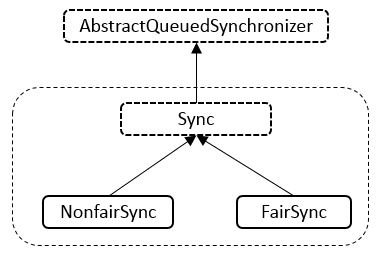可重入锁ReentrantLock的底层是通过AbstractQueuedSynchronizer实现。
带着BAT大厂的面试问题去理解
什么是可重入,什么是可重入锁? 它用来解决什么问题?
ReentrantLock的核心是AQS,那么它怎么来实现的,继承吗? 说说其类内部结构关系。
ReentrantLock是如何实现公平锁的?
ReentrantLock是如何实现非公平锁的?
ReentrantLock默认实现的是公平还是非公平锁?
使用ReentrantLock实现公平和非公平锁的示例?
ReentrantLock和Synchronized的对比?
ReentrantLock源码分析 类的继承关系 ReentrantLock实现了Lock接口,Lock接口中定义了lock与unlock相关操作,并且还存在newCondition方法,表示生成一个条件。
1 2 3 4 5 6 7 8 9 public class ReentrantLock implements Lock , java .io .Serializable abstract static class Sync extends AbstractQueuedSynchronizer static final class NonfairSync extends Sync static final class FairSync extends Sync }
内部类 ReentrantLock总共有三个内部类,并且三个内部类是紧密相关的,下面先看三个类的关系。
ReentrantLock类内部总共存在Sync、NonfairSync、FairSync三个类,NonfairSync与FairSync类继承自Sync类,Sync类继承自AbstractQueuedSynchronizer抽象类。
Sync类 1 2 3 4 5 6 7 8 9 10 11 12 13 14 15 16 17 18 19 20 21 22 23 24 25 26 27 28 29 30 31 32 33 34 35 36 37 38 39 40 41 42 43 44 45 46 47 48 49 50 51 52 53 54 55 56 57 58 59 60 61 62 63 64 65 66 67 68 69 70 71 72 73 74 75 76 77 78 79 80 81 82 83 84 85 86 87 abstract static class Sync extends AbstractQueuedSynchronizer private static final long serialVersionUID = -5179523762034025860L ; abstract void lock () final boolean nonfairTryAcquire (int acquires) final Thread current = Thread.currentThread(); int c = getState(); if (c == 0 ) { if (compareAndSetState(0 , acquires)) { setExclusiveOwnerThread(current); return true ; } } else if (current == getExclusiveOwnerThread()) { int nextc = c + acquires; if (nextc < 0 ) throw new Error("Maximum lock count exceeded" ); setState(nextc); return true ; } return false ; } protected final boolean tryRelease (int releases) int c = getState() - releases; if (Thread.currentThread() != getExclusiveOwnerThread()) throw new IllegalMonitorStateException(); boolean free = false ; if (c == 0 ) { free = true ; setExclusiveOwnerThread(null ); } setState(c); return free; } protected final boolean isHeldExclusively () return getExclusiveOwnerThread() == Thread.currentThread(); } final ConditionObject newCondition () return new ConditionObject(); } final Thread getOwner () return getState() == 0 ? null : getExclusiveOwnerThread(); } final int getHoldCount () return isHeldExclusively() ? getState() : 0 ; } final boolean isLocked () return getState() != 0 ; } private void readObject (java.io.ObjectInputStream s) throws java.io.IOException, ClassNotFoundException { s.defaultReadObject(); setState(0 ); } }
NonfairSync类 NonfairSync类继承了Sync类,表示采用非公平策略获取锁,其实现了Sync类中抽象的lock方法。
1 2 3 4 5 6 7 8 9 10 11 12 13 14 15 16 17 18 19 static final class NonfairSync extends Sync private static final long serialVersionUID = 7316153563782823691L ; final void lock () if (compareAndSetState(0 , 1 )) setExclusiveOwnerThread(Thread.currentThread()); else acquire(1 ); } protected final boolean tryAcquire (int acquires) return nonfairTryAcquire(acquires); } }
从NonfairSync#lock方法 的源码可知,lock时先compareAndSetState(0, 1)尝试获取锁,而并不会按照公平等待的原则进行等待,让sync queue中的第一个线程获得锁。
FairSyn类 FairSync类也继承了Sync类,表示采用公平策略获取锁,其实现了Sync类中的抽象lock方法。
1 2 3 4 5 6 7 8 9 10 11 12 13 14 15 16 17 18 19 20 21 22 23 24 25 26 27 28 29 30 31 32 33 34 35 36 37 38 39 40 static final class FairSync extends Sync private static final long serialVersionUID = -3000897897090466540L ; final void lock () acquire(1 ); } protected final boolean tryAcquire (int acquires) final Thread current = Thread.currentThread(); int c = getState(); if (c == 0 ) { if (!hasQueuedPredecessors() && compareAndSetState(0 , acquires)) { setExclusiveOwnerThread(current); return true ; } } else if (current == getExclusiveOwnerThread()) { int nextc = c + acquires; if (nextc < 0 ) throw new Error("Maximum lock count exceeded" ); setState(nextc); return true ; } return false ; } }
只要资源被其他线程占用,FairSyn 会将该线程添加到sync queue中的尾部,而不会先尝试获取资源。Nonfair 最大的区别,Nonfair每一次都会尝试去compareAndSetState获取资源(有两次机会),如果此时该资源恰好被释放,则会被当前线程获取,这就造成了不公平的现象 ,当获取不成功,再加入队列尾部。
公平锁下,同步队列Sync queue的头节点线程一定可以拿到资源吗?
类的属性 1 2 3 4 5 6 public class ReentrantLock implements Lock , java .io .Serializable private static final long serialVersionUID = 7373984872572414699L ; private final Sync sync; }
ReentrantLock类的sync非常重要,对ReentrantLock类的操作大部分都直接转化为对Sync和AbstractQueuedSynchronizer类的操作。
构造函数
ReentrantLock() 1 2 3 4 public ReentrantLock () sync = new NonfairSync(); }
ReentrantLock(boolean fair)1 2 3 public ReentrantLock (boolean fair) sync = fair ? new FairSync() : new NonfairSync(); }
核心方法 通过分析ReentrantLock的源码,可知对其操作都转化为对Sync对象的操作,由于Sync继承了AQS,所以基本上都可以转化为对AQS的操作。
示例分析 可重入的例子 1 2 3 4 5 6 7 8 9 10 11 12 13 14 15 16 17 18 19 20 21 22 23 24 25 26 27 public class ReentrantLockExample private ReentrantLock lock = new ReentrantLock(); public void method1 () lock.lock(); try { method2(); } finally { lock.unlock(); } } public void method2 () lock.lock(); try { } finally { lock.unlock(); } } public static void main (String[] args) ReentrantLockExample example = new ReentrantLockExample(); example.method1(); } }
